
Myth or reality? From Myth to Reality
Unpowered flight has been the dream of man since the earliest times. Its often difficult to distinguish between myth and reality when describing historical attempts to fly until those of the last few centuries. The following has drawn together some interesting and lesser know facts around these efforts to reach for the sky.
Any summary of Man’s attempts to fly must start with the classic myth of ancient Greece.

The Flight Of Daedalus And Icarus
The ancient Greek myth of Daedalus and Icarus is one of the most well known and fascinating Greek Myths as it consists of both historical and mythical details.
Legendary inventor and architect, Daedalus (he was the one who designed the Labyrinth on the island of Crete) managed to create gigantic wings, using branches of osier and connected them with wax. He taught Icarus how to fly, but told him to keep away from the sun because the heat would make the wax melt, destroying the wings.
Although he was warned, Icarus was too young and too enthusiastic about flying. He got excited by the thrill of flying and carried away by the amazing feeling of freedom and started flying high to salute the sun, diving low to the sea, and then up high again.
His father Daedalus was trying in vain to make young Icarus to understand that his behavior was dangerous, and Icarus soon saw his wings melting when he flew too close to the sun. He fell into the sea and drowned. Unfortunately a sad demise would be the destiny of many of the intrepid aeronauts that followed Daedalus and Icarus .
—oOo—
The Age of the True Believers. Unpowered ‘Heavier Than Air’ Flight….
Diego Marín Aguilera (1793) was a little known Spaniard who was inspired by the eagles he spotted while tending his animals and fields: he wanted to build a flying machine. For six years, he worked on the one he invented. The machine was built out of wood, iron, cloth, and feathers. On the night of May 15, 1793, accompanied by the blacksmith Barbero and one of Marín’s sisters, Marín placed his glider on the highest part of the castle of Coruña del Conde in the light of the full moon.
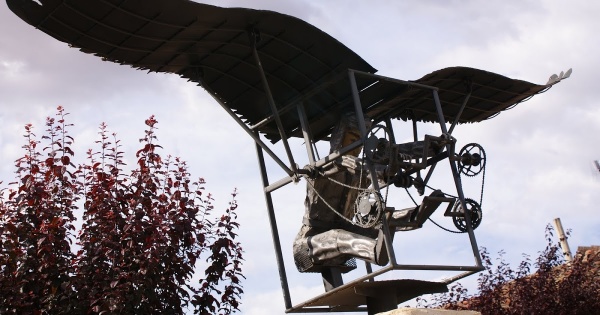
Flapping the wings of the glider, he reached a height of “six or seven varas” (approximately 5 or 6 m) and according to his companions, glided for “431 Castilian varas“,[ or approximately 300 to 400 metres. Marín managed to cross the river Arandilla and reached the area known as Heras, where he crash-landed after one of the metal joints broke leaving him only scratched and bruised . Further bad luck followed however….
The inhabitants of the town, believing him to be a lunatic, heretic, or a fraud, burned his “demonic” flapping-wing creation. Marín lost all hope and, feeling disgraced and deeply depressed, never attempted flight again. He died at the age of 44 in his native town, six years after his attempted flight.[
The above does not do justice to Diego’s ingenuity. He constructed his craft using thin walled hollow square metal tubing — which allowed for both strength and light weight.
The whole field of metallurgy had advanced so much since Da Vinci’s time nearly two centuries previously when wood was the primary material available. Now called the “father of aviation” in Spain, the Spanish Air Force dedicated a monument to Diego that is located next to the castle where he took flight.
George Cayley (1804) was an English engineer and inventor who pioneered aeronautical engineering and is sometimes referred to as “the father of aviation.”[2] He discovered and identified the four forces which act on a heavier-than-air flying vehicle: weight, lift, drag and thrust.[5] Modern aeroplane design is based on those discoveries and on the importance of cambered wings, also identified by Cayley.[6]
The model glider successfully flown by Cayley in 1804 had the layout of a modern aircraft, with a kite-shaped wing towards the front and an adjustable tailplane at the back consisting of horizontal stabilisers and a vertical fin. A movable weight allowed adjustment of the model’s centre of gravity. A replica of the 1853 machine was flown at the original site in Brompton Dale by Derek Piggott in 1973[22] for TV and in the mid-1980s[23] for the IMAX film On The Wing.

Otto Lilienthal (1891) was the first person to make well-documented, repeated, successful flights with glider. Newspapers and magazines published photographs of Lilienthal gliding, favorably influencing public and scientific opinion about the possibility of flying machines becoming practical.
Otto was German and made his flights from an artificial hill he built near Berlin and from natural hills, especially in the Rhinow region. He developed many models and built many small, fragile gliders. In these he made about 2000 controlled flights.
Lilienthal controlled them by changing the centre of gravity by shifting his body, much like modern hang gliders. On 9 August 1896, his glider stalled and he was unable to regain control. Falling from about 15 m (50 ft), he broke his neck and died the next day, 10 August 1896.

Meanwhile in Oz
Lawrence Hargrave (1894) was an Australian inventor and experimenter who gave particular attention to the flight of birds. He chose to live and experiment with his flying machines in Stanwell Park, just south of Sydney. This location offers excellent wind and hang gliding conditions and nowadays is the most famous hang gliding and paragliding venue in Australia.
An exceptionally generous man with his time and discoveries, he shared them with other inventors and early aviation pioneers. He refused to patent his work in case it retarded the work of others in pursuing aeronautical discoveries. Alexander Graham Bell, the Wright Brothers and George Taylor were among those who were inspired by, benefited from and acknowledged Hargave’s pioneering work.

Hargrave successfully lifted himself off the ground under a train of four of his box kites at Stanwell Park Beach on 12 November 1894.
Among many, three of Hargrave’s inventions were particularly significant:
- Study of curved aerofoils, particularly designs with a thicker leading edge.
- The box kite (1893), which greatly improved the lift to drag ratio of early gliders.
- Work on the rotary engine which powered many early aircraft up until about 1920.

This is an artist’s rendition of Hargave’s experiment where he was lifted 5 metres (16 feet) from the ground by a series of box kites. If you follow the connecting ropes in the sketch its unlikely the kites were
actually configured this way as the lifting force does not follow a common line.
Octave Chanute (1896) Was a French born American civil engineer. He was too old to fly himself so he provided many budding enthusiasts, including the Wright bros. with help and advice, He partnered with younger experimenters, including Augustus Herring and William Avery. Together, they tested a design based on the work of German aviation pioneer Otto Lilienthal as well as hang gliders of their own design in the dunes along the shore of Lake Michigan. Chanute introduced the “strut-wire” braced wing structure that would be used in powered biplanes of the future.
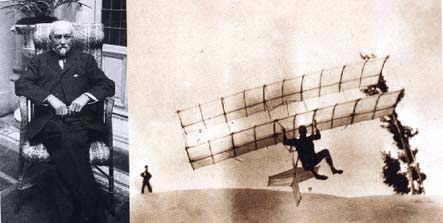
Chanute and his 1896 biplane hang glider, a trailblazing design adapted by the Wright brothers[4]
The Wright Brothers (1900-1902) experimented with unpowered gliders during the lead up to their first successful first powered flight in 1903. In September 1903 they brought the 1902 glider out of storage and made over 200 glides to hone their piloting skills while preparing the powered Wright Flyer for its historic December 1903 flight.

There was a strong sense of mutual support among the early pioneers and they often readily shared their theories, designs and formula with each other and acknowledged the support of others. Not so the Wrights however. Although openly acknowledging that many of their ideas were based on or derived from the work of Cayley, Hargraves, Lilienthal and others, the Wrights took out myriad patents of their own work and aggressively litigated against anyone they considered to be infringing on them. These distractions significantly retarded their own ongoing aeronautical development..
https://en.m.wikipedia.org/wiki/Wright_brothers_patent_war
Back in Oz
George Taylor (December 5, 1909) :achieved the first flight of a heavier-than-air machine in Australia, placing Narrabeen on Australia’s aviation map. Taylor, inspired by pioneer aviator Lawrence Hargrave, had built a biplane with a box-kite tail for balance, from coachwood, covered with oiled calico.
George Taylor took his position on the lower wing. In a series of dips and curves he glided 90 metres (98 yards) from 1 to 5 metres (3 to 15 feet) above the sand. Later he travelled over 230 metres (253 yards) and finished up in the surf!

Carroll, Brian 1980, Australian Aviators : An Illustrated History,
—oOo—
Between the Wars From Minutes to Hours
In Germany The sport of gliding only emerged after the First World War. This was a result of the Treaty of Versailles, which imposed severe restrictions on the manufacture and use of single-seat powered aircraft in Germany’s Weimar Republic. Part Five of the treaty required the destruction or surrender of all German military aircraft, banned the production of aircraft, and prohibited all military flying. Gliders, unpowered aircraft used by amateur pilots, were not included in the Versailles restrictions.
The first German gliding competition was held at the Wasserkuppe (a large plateau in the Rohn Mountains) in 1920, organized by Oskar Ursinus. The best flight lasted two minutes and set a world distance record of 2 kilometres (1.2 mi). Within ten years, it had become an international event in which the achieved durations and distances had increased greatly. In 1931, Gunther Grönhoff flew 272 kilometres (169 mi) on the front of a storm from Munich to Kadaň (Kaaden in German) in Western Czechoslovakia, further than had ever been thought possible.
Thus, in the 1920s and 1930s, while aviators and aircraft makers in the rest of the world were working to improve the performance of powered aircraft, the Germans were designing, developing and flying ever more efficient gliders. They were discovering ways of using the natural forces in the atmosphere to make them fly farther and faster. German glider pilots assisted with the development of the sport in North America.
In the USA (1928), Peter Hesselbach, premier flier of the Darmstadt Academic in Rossiten, Germany, was catapulted up from Corn Hill in Truro in a glider craft just like the one that had recently set a world record for time aloft. Hesselbach stayed up for four hours and five minutes, hanging over Cape Cod Bay, going back and forth over a 19-mile area. When the flight mileage was calculated, it was 120 miles.

The simple gliders were catapulted up and off a sand dune or low hill by pulling back an elastic rope hooked onto the glider’s nose. It takes a few crew members to handle the operation, pulling back on the rope and holding the tail in place. Once the signal is given and the glider catapults, the rope unhooks from the nose, and then it’s up to the pilot to operate the glider’s pedals and stick.
The pilot’s goal was to stay up, and ideally land the glider at the top of the dune or hill. Horses were often used to pull the machines back up to the launching location..
Before Hesselbach’s 1928 flight, Orville Wright held the U.S. record for the nine minutes, 45 seconds he achieved in 1911, in his box-like invention first tested and flown at Kitty Hawk, North Carolina.
With the active support of the German government, there were 50,000 active glider pilots in that country by 1937. Nazi Germany had a massive pool of highly experienced aviators at its disposal as world war approached. Those glider pilots could be quite readily trained to fly powered military aircraft of all forms.
—oOo—
World War 2 The Age of the Heavy Military Glider
Military Gliders of WW 2 Along with unprecedented technological progress in aircraft development due to the urgency of the war effort, WW2 saw the rapid development of transport gliders. Most Allied and Axis countries developed military gliders. Along with the larger US, UK, Germany, Russia and Japanese production, Australia, Sweden, Italy, India and Turkey produced various limited versions.
These large gliders were towed to the battlefields behind even larger multi engined powered aircraft like bombers and DC3s (Dakotas).

The British Horsa, was a large glider with a wingspan of almost 27 metres and was capable of accommodating up to 30 fully equipped paratroopers. There were over 3000 built.


In 1940 Churchill ordered the develop of a larger glider which would be able to transport heavy equipment in support of airborne troops. Hamilcars first saw action in June 1944, when approximately thirty were used to carry 17-pounder anti-tank guns, transport vehicles and Tetrarch light tanks into Normandy in support of British airborne forces during Operation Tonga. 340 were built.
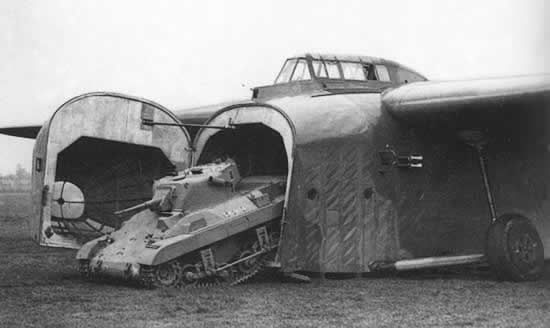
The following are fascinating videos with some unusual original footage showing US and Allied use of military gliders during WW2
https://www.youtube.com/watch?v=qSc1vBpCM2w
Australia’s contribution to military glider development was in the form of the
De Havilland Australia DHA-G1 and G2 . They had a 15 metre wingspan (the same wingspan as most modern single seat gliders) and carried six troops plus the pilot.
Germany’s most successful designs were the Gotha Go 242 (1500 built) a twin boom design which could carry twenty troops and the Messerschmitt Me 321 Gigant (330 built)
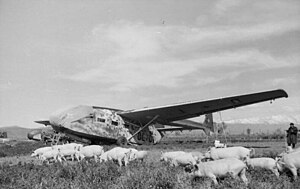
The Me 321 prototype was a shoulder winged aircraft with a wingspan of a whopping 55 metres! The Airbus A330 has only a slightly wider 60 metre wingspan. its internal cargo space measuedg 36 ft 1 in (11.00 m) in length, 10 ft 4 in (3.15 m) in width and 10 ft 10 in (3.30 m) in height.
The Me 321 had a staggering capacity for 120 troops or up to 44,092 lb (20,000 kg) of cargo, almost double the empty weight. Flight tests were conducted using a jettisonable take off dolly, with sprung skids used for landing.[2]

As a final interesting WW2 glider, the Blohn and Voss BV 40 was a particularly unusual design with an equally unusual role. It was the only production glider ever designed to carry armament. It had an armoured cockpit with the pilot laying prone (horizontal) and was fitted with two 30mm Mk 108 cannons mounted near the wing root would you believe?
The German plan was to launch two of these behind an Me 109 fighter to above the cruising levels of allied bombers. The BV40s would then release with the intent of diving at high speed (never exceed speed 900kph!) and at a steep angle at bombers and hope for two passes before gliding to earth. Only seven were ever built during 1944 and the project was cancelled that year as the aircraft was considered just too dangerous for its pilots.

The BV 40.
—oOo—
Following World War 2 The boom in wooden glider construction

Enthusiasm for sport aviation stimulated the development of both gliding and gliders post war. The pre-war altitude record was doubled by 1950. In many countries during the 1950s a large number of trained pilots wanted to continue flying as a sport and recreational activity. Many of these were also aeronautical engineers who could design, build and maintain gliders. They started gliding clubs, manufacturers and supervising national bodies. A number of these still exist today.
The Gliding Federation of Australia (GFA) is the governing body for the sport of gliding in Australia. It was founded in 1949. The GFA has remained responsible to Civil Aviation Safety Authority (CASA) for the conduct of safe gliding operations in Australia. It administers all operational, engineering (airworthiness), training and competition standards and advocates for the sport of gliding both nationally and internationally.

British Gliding History 1952 BRITISH FILM PHILIP WILLS with some War War 11 gliding footage form 11.30.
https://www.youtube.com/watch?v=117P3ZeLdRk
Wood and fabric were the primary construction materials. The Schleicher Ka 6 was developed in the mid 1950s in Germany and was typical of the higher performance production gliders of that era. It was constructed of Spruce and plywood with fabric covering and had a fixed main wheel and nose skid. The model went through a series of developments finishing in 1965 with the Ka6E with its all flying tailplane.
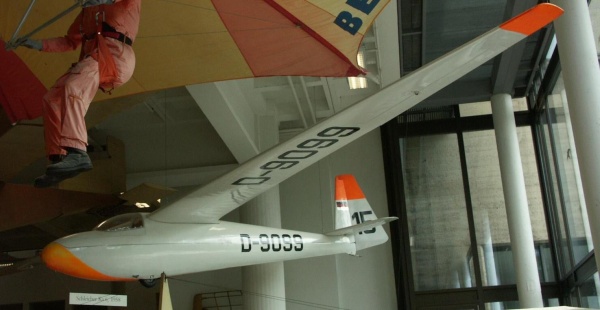
Metal fabrication was also applied to glider design and construction. The all metal Sisu 1A was built in the late 1950s and early 1960s primarily as a competition glider. It had an astounding (for its time) glide ratio of 44:1. This means that in still air, for every unit of height it has vertically, it can glide 44 units horizontally! On July 31, 1964, a Sisu 1a piloted by Alvin H. Parker became the first sailplane ever to fly farther than 1000 km. This distance was consider the ‘four minute mile’ of cross country gliding.
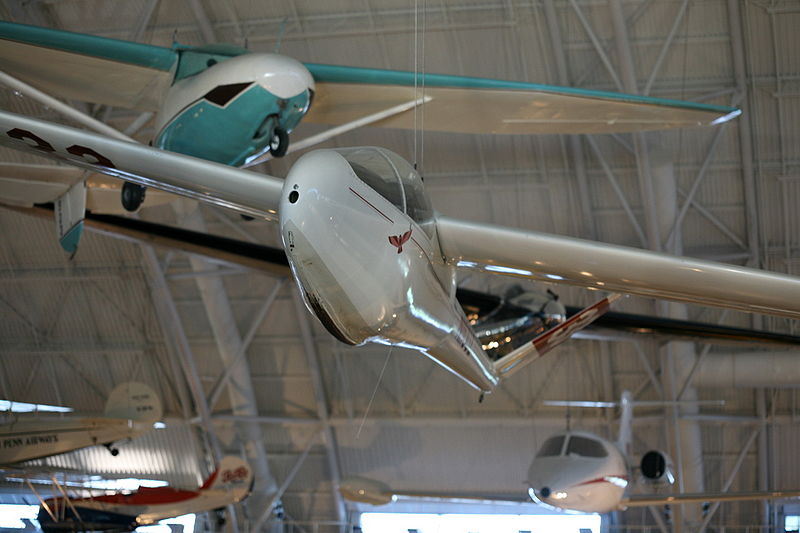
Wood however remained the most accessible and workable material for glider construction, especially for home builders.The lightweight Ka6 German design however was not well suited to the strong weather conditions in Australia. In the 1960s the GFA asked Edmund Schneider of Adelaide to design and manufacture a competition sailplane better suited to Australian conditions. The result was the ES-60 Boomerang. The Boomerang has an all-moving, swept tailplane that resembles a boomerang and hence the name given to the ES-60.
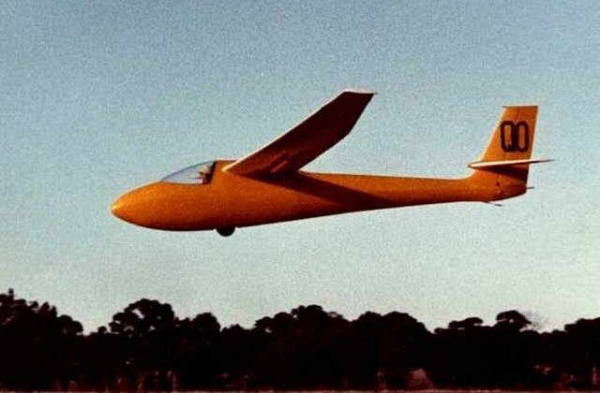
—oOo—
The Age of Plastics From Fibreglass to Kevlar
New materials such as glass fibre and carbon fibre, advances in wing shapes and airfoils saw a plethora of new designs which took advantage of the higher strength to weight ratio of fibreglass reinforced plastics. The Schleicher ASW-15 designed in 1968 by Gerhard Waibel and manufactured by Alexander Schleicher GmbH & Co. is a typical example of first generation fibreglass gliders. The first 1,000-kilometre (620 mi) flight was achieved in 1964.
The ASW-15 has shoulder-mounted wings and an all-flying tailplane with its single tow-release placement a compromise between winching and aerotowing.
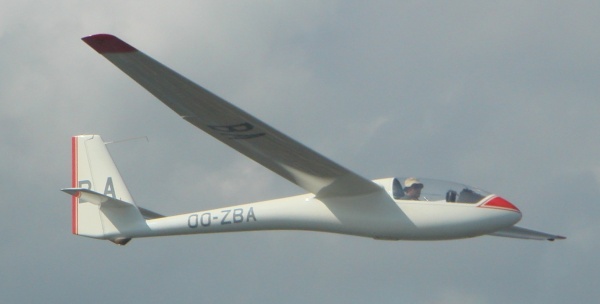
Glass fiber and later carbon fibre generated rapid development and increasing performance gains through the increased strength-to-weight ratio of these materials. The 1970s saw the introduction of the Standard Cirrus. (‘Standard’ refers to a class of glider with a 15 metre wingspan and without flaps)
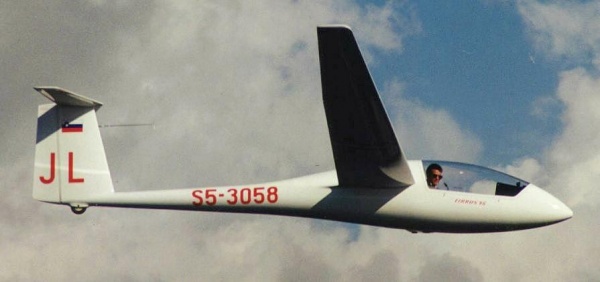
The membership of the Soaring Society of America increased from 1,000 to 16,000 by 1980. The increased numbers of pilots, greater knowledge and improving technology helped set new records. A flight from Benalla in Victoria of over 1200 km was flown by the 2017 World Open Class Champion, Michael Sommer.
Most modern gliders are a mix of fibreglass, carbon fibre and kevlar. Decisions around the balance between strength requirements, weight and cost determine the proportions and location of each. For anyone interested in the use of modern materials in sailplane construction, the following article is both informative and highly detailed…
Recent decades have seen the development of highly sophisticated electronic instruments. The Global Positioning System (GPS) and detailed scientific studies of gliding meteorology combined with improved weather forecasting has seen tremendous gains. These have allowed many pilots to make flights that were once extraordinary.
Thousands of flights over 1,000 kilometres (620 mi) have been made. Although there is no Olympic competition, there are the World Gliding Championships. The first event was held at the Samedan in 1948. Since World War II it has been held every two years. There are now six classes open to both sexes, plus three classes for women and two junior classes.
—oOo—
The Future The Future is Here
Electric Powered Gliders
Ongoing development of higher performing sailplanes and of power sources for self launching gliders continues at a pace. The traditional aero tow means of launching gliders behind a light aircraft has suffered and will suffer further from escalating operating costs and staffing requirements. The capability to launch and to operate independently of a ground crew and at lower operating costs is enticing.
Electric self launching gliders are currently found either of two configurations. The previously petrol powered ‘pop up’ engine design replaced with an electric motor, or FES (Front Electric Self Launch) configuration. The pylon mounted propeller is raised for launching then lowered for streamlined gliding flight. The Taurus in the video below is unusual in having side by side cockpit seating in a modern sailplane.

FES or Front Electric Self Launch are gaining a foothold in gliding because of their clean energy credentials. Propeller blades powered by a small electric motor extend from the glider’s nose cone when in use and then retract out of sight when not. The FES system is primarily for sustaining height and for self launching of lighter gliders.
The Perlan Project To The Heavens
Perlan Project Inc. is a not-for-profit aeronautical exploration and atmospheric science research organization that utilizes gliders (sailplanes) designed to fly at extremely high altitudes. On August 29, 2006 Steve Fossett and Einar Enevoldson, the pilots of Perlan Mission I, broke the existing altitude record for gliders by soaring up to 50,671 feet (15,460m) in a standard glider using stratospheric waves of air.
The project is awaiting ratification of altitude records of 18,492 m (60,669 ft) on August 26, 2018, 19,439 m (63,776 ft) on August 28, 2018 and 22,646 m (74,298 ft) on September 2, 2018.[1]
NOTABLE GLIDER PILOTS THROUGH THE YEARS
https://en.wikipedia.org/wiki/List_of_glider_pilots